
LOADING ...
In response to evolving domestic opinion, eMedals Inc has made the conscious decision to remove the presentation of German Third Reich historical artifacts from our online catalogue. For three decades, eMedals Inc has made an effort to preserve history in all its forms. As historians and researchers, we have managed sensitive articles and materials with the greatest of care and respect for their past and present social context. We acknowledge the growing sentiments put forth by the Canadian public and have taken proactive actions to address this opinion.
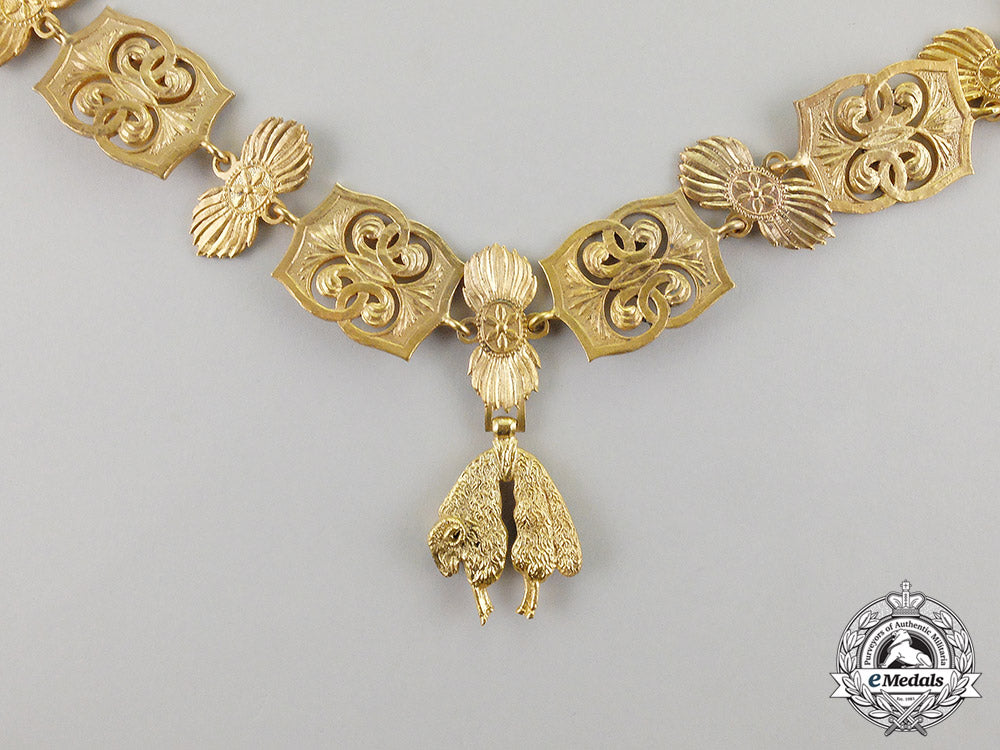
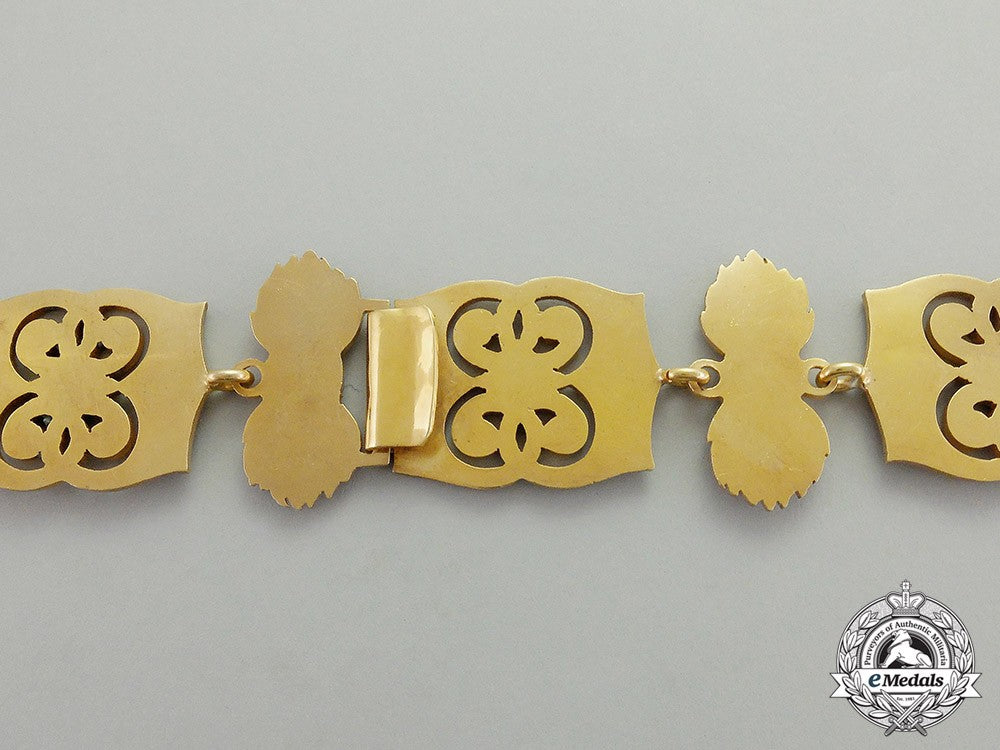
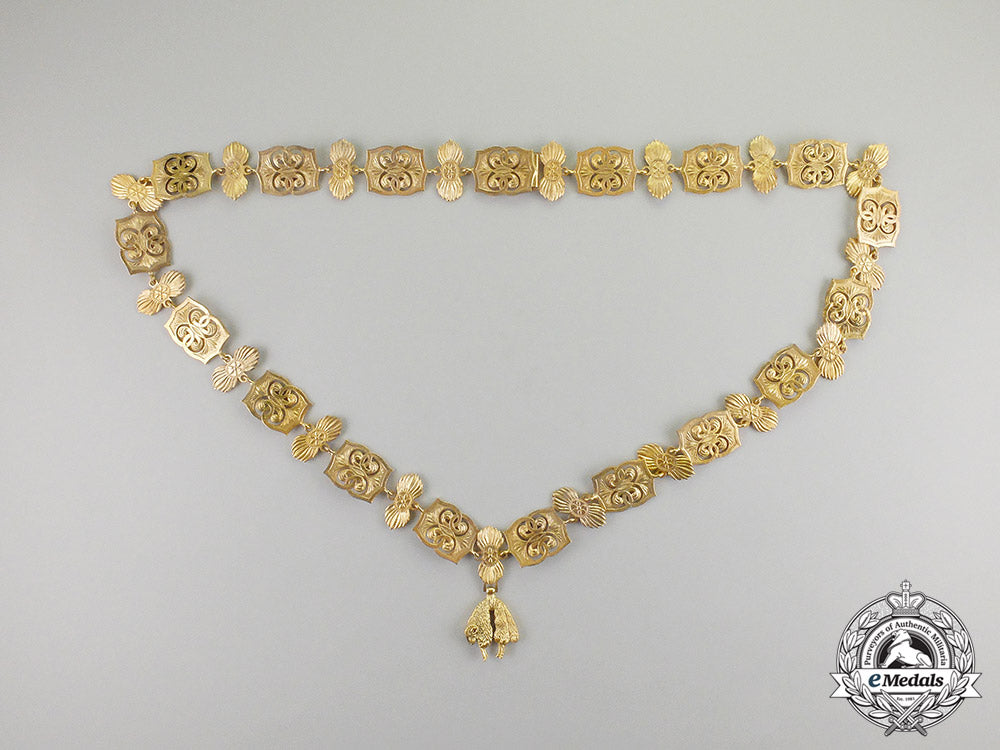
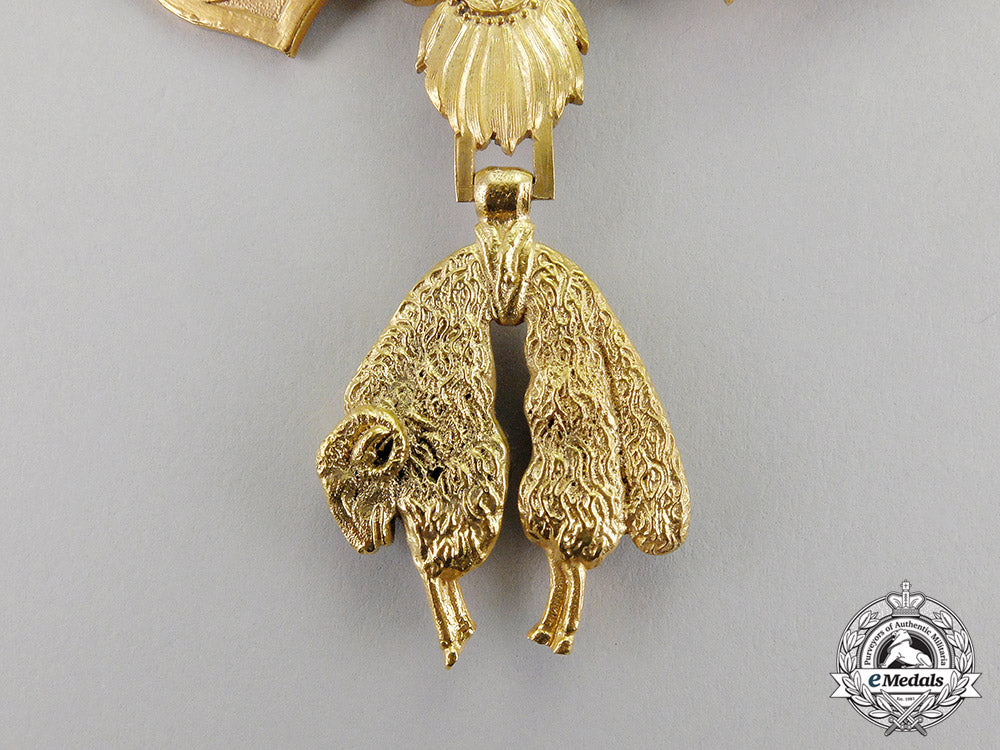
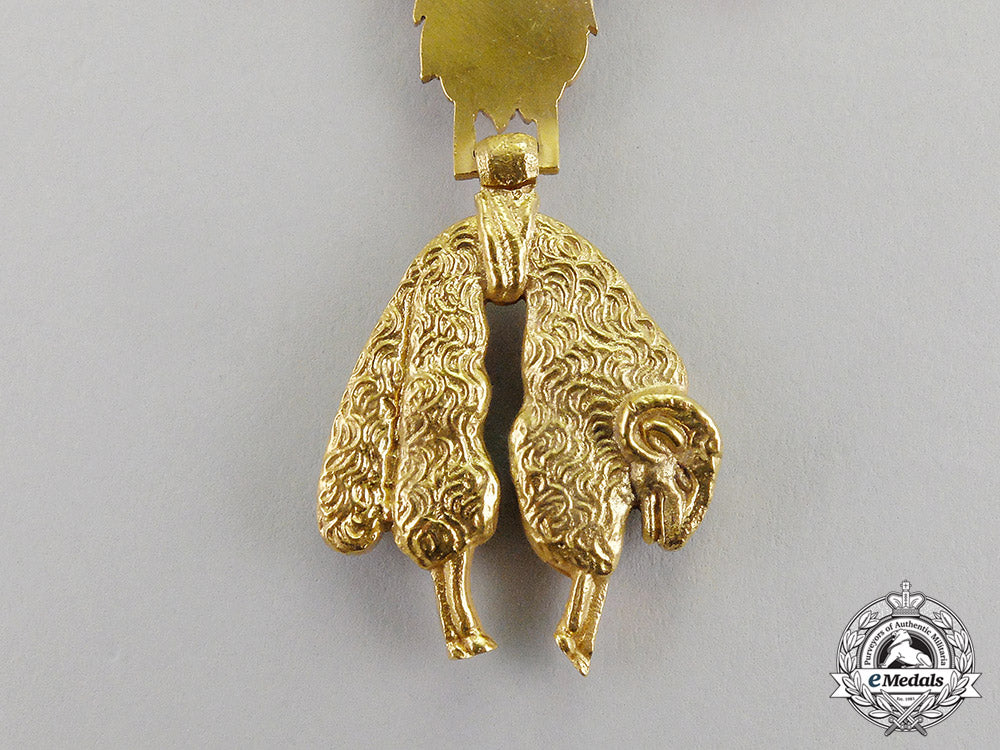
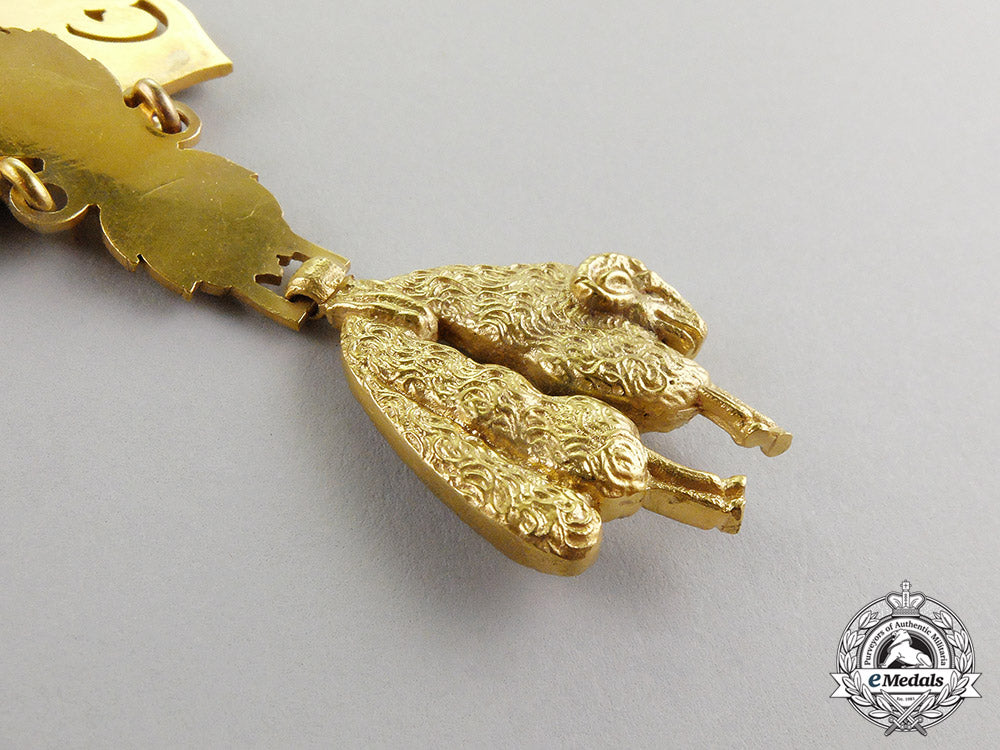
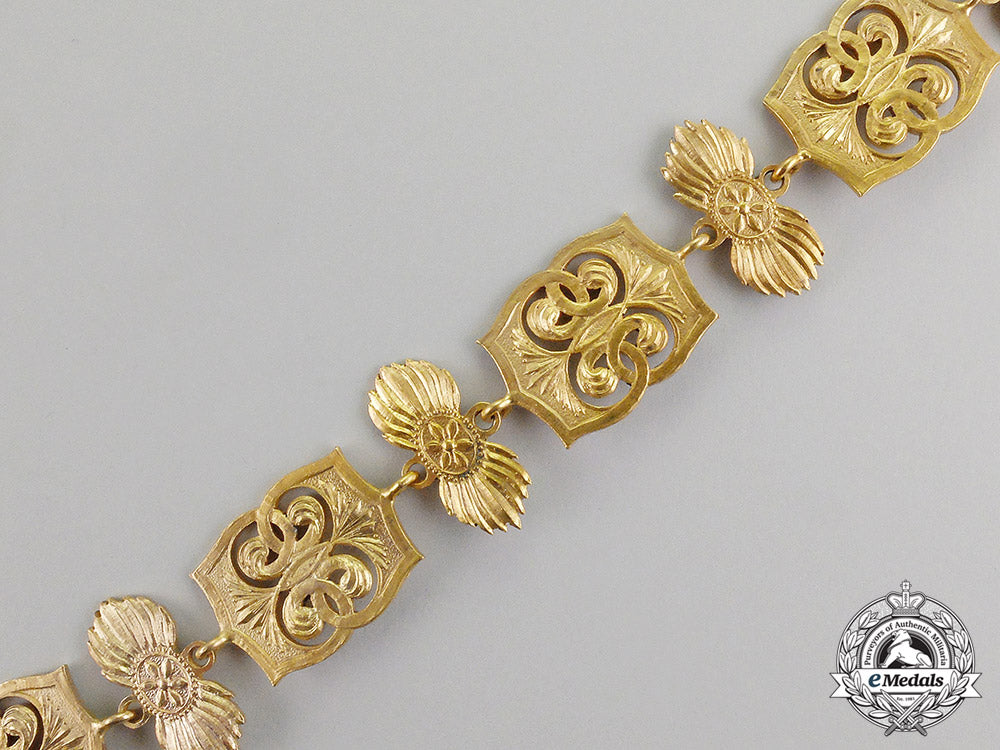
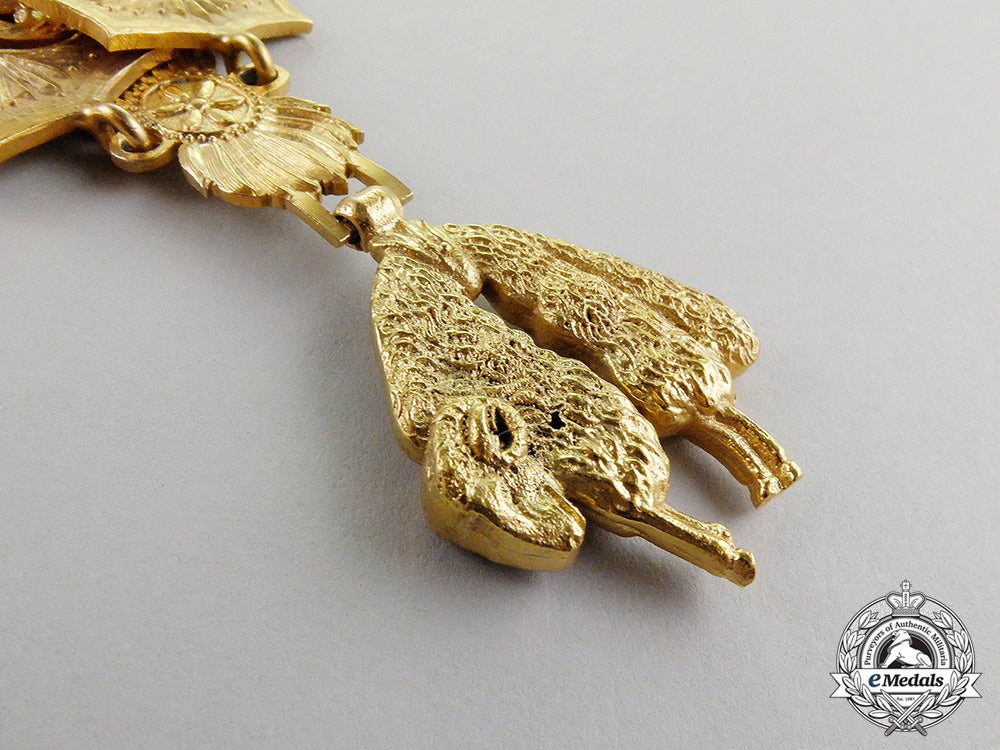
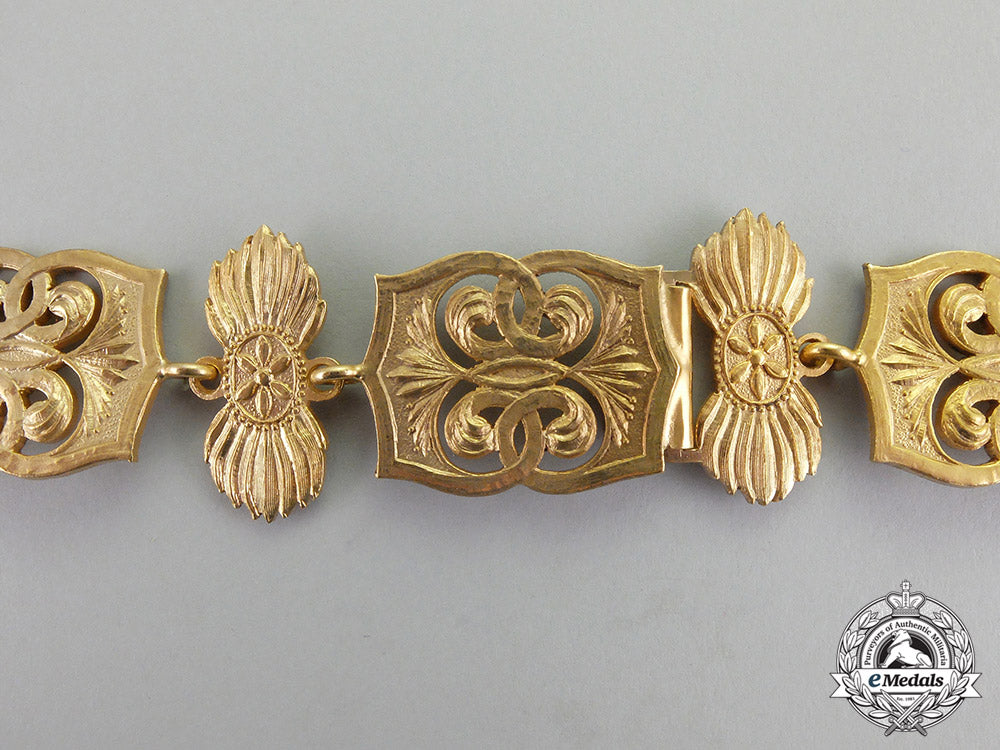
Spain. An Order Of The Golden Fleece, Collar Chain, C.1970
Spain. An Order Of The Golden Fleece, Collar Chain, C.1970
SKU: ITEM: EU14572
Current Bid:
Your Max Bid:
Bid History:
Time Remaining:
Couldn't load pickup availability
Shipping Details
Shipping Details
eMedals offers rapid domestic and international shipping. Orders received prior to 12:00pm (EST) will be shipped on the same business day.* Orders placed on Canadian Federal holidays will be dispatched the subsequent business day. Courier tracking numbers are provided for all shipments. All items purchased from eMedals can be returned for a full monetary refund or merchandise credit, providing the criteria presented in our Terms & Conditions are met. *Please note that the addition of a COA may impact dispatch time.
Shipping Details
eMedals offers rapid domestic and international shipping. Orders received prior to 12:00pm (EST) will be shipped on the same business day.* Orders placed on Canadian Federal holidays will be dispatched the subsequent business day. Courier tracking numbers are provided for all shipments. All items purchased from eMedals can be returned for a full monetary refund or merchandise credit, providing the criteria presented in our Terms & Conditions are met. *Please note that the addition of a COA may impact dispatch time.
Description
Description
In bronze gilt, composed of thirty-seven icons, with eighteen 30.3 mm (h) x 13 mm (h) flame insignia alternating with eighteen 24 mm (w) x 31 mm (h) ornate frame insignia designed with swirls, the ninth flame from the left positioned in the centre with the 27 mm (w) x 36.5 mm (h) sheep insignia dangling from it, each of the insignia with a single loop on either end and linked together, the open end of the chain with a ornate frame insignia incorporating a clip, facing a flame insignia with a loop to receive the clip, ensuring a snug enclosure behind the neck, the chain measuring approximately 950 mm in length, extremely fine.
Footnote: The Order of the Golden Fleece is a Roman Catholic order of chivalry founded in Bruges by the Burgundian duke Philip the Good in 1430, to celebrate his marriage to the Portuguese princess Isabella. It became one of the most prestigious orders in Europe. Today, two branches of the Order exist, namely the Spanish and the Austrian Fleece; the current grand masters are Felipe VI, King of Spain, and Karl von Habsburg, grandson of Emperor Charles I of Austria, respectively. The chaplain of the Austrian branch is Cardinal Graf von Schönborn, Archbishop of Vienna. The Order of the Golden Fleece was established on January 10, 1430, by Philip the Good, Duke of Burgundy, in celebration of the prosperous and wealthy domains united in his person that ran from Flanders to Switzerland. It is restricted to a limited number of knights, initially twenty-four but increased to thirty in 1433, and fifty in 1516, plus the sovereign. The Order's first King of Arms was Jean Le Fèvre de Saint-Remy. It received further privileges unusual to any order of knighthood: the sovereign undertook to consult the order before going to war; all disputes between the knights were to be settled by the order; at each chapter the deeds of each knight were held in review, and punishments and admonitions were dealt out to offenders, and to this the sovereign was expressly subject; the knights could claim as of right to be tried by their fellows on charges of rebellion, heresy and treason, and Charles V conferred on the order exclusive jurisdiction over all crimes committed by the knights; the arrest of the offender had to be by warrant signed by at least six knights, and during the process of charge and trial he remained not in prison but in the gentle custody of his fellow knights. The order, conceived in an ecclesiastical spirit in which mass and obsequies were prominent and the knights were seated in choirstalls like canons, was explicitly denied to heretics, and so became an exclusively Catholic honour during the Reformation. The officers of the order were the chancellor, the treasurer, the registrar, and the King of Arms, or herald, "Toison d'Or". The Duke's stated reason for founding this institution had been given in a proclamation issued following his marriage, in which he wrote that he had done so "for the reverence of God and the maintenance of our Christian Faith, and to honour and exalt the noble order of knighthood, and also ...to do honour to old knights; ...so that those who are at present still capable and strong of body and do each day the deeds pertaining to chivalry shall have cause to continue from good to better; and .. so that those knights and gentlemen who shall see worn the order ... should honour those who wear it, and be encouraged to employ themselves in noble deeds...".
The choice of the Golden Fleeceof Colchis as the symbol of a Christian order caused some controversy, not so much because of its pagan context, which could be incorporated in chivalric ideals, as in the Nine Worthies, but because the feats of Jason, familiar to all, were not without causes of reproach, expressed in anti-Burgundian terms by Alain Chartier in his Ballade de Fougères referring to Jason as "Who, to carry off the fleece of Colchis, was willing to commit perjury." The bishop of Châlons, chancellor of the Order, rescued the fleece's reputation by identifying it instead with the fleece of Gideon that received the dew of Heaven. The badge of the Order, in the form of a sheepskin, was suspended from a jewelled collar of firesteels in the shape of the letter B, for Burgundy, linked by flints; with the motto "Pretium Laborum Non Vile" ("No Mean Reward for Labours") engraved on the front of the central link, and Philip's motto "Non Aliud" ("I will have no other") on the back (non-royal knights of the Golden Fleece were forbidden to belong to any other order of knighthood). With the absorption of the Burgundian lands into the Spanish Habsburg empire, the sovereignty of the Order passed to the Habsburg kings of Spain, where it remained until the death of the last of the Spanish Habsburgs, Charles II, in 1700. He was succeeded as king by Philip V, a Bourbon. The dispute between Philip and the Habsburg pretender to the Spanish throne, the Archduke Charles, led to the War of the Spanish Succession, and also resulted in the division of the Order into Spanish and Austrian branches. In either case the sovereign, as Duke of Burgundy, writes the letter of appointment in French. The controversial conferral of the Fleece on Napoleon and his brother Joseph, while Spain was occupied by French troops, angered the exiled King of France, Louis XVIII, and caused him to return his collar in protest. These, and other awards by Joseph, were revoked by King Ferdinand on the restoration of Bourbon rule in 1813. Napoleon created by Order of August 15, 1809 the Order of the Three Golden Fleeces, in view of his sovereignty over Austria, Spain and Burgundy. This was opposed by Joseph I of Spain and appointments to the new order were never made. In 1812, the acting government of Spain conferred the Fleece upon the Duke of Wellington, an act confirmed by Ferdinand on his resumption of power, with the approval of Pope Pius VII. Wellington therefore became the first Protestant to be honoured with the Golden Fleece. It has subsequently also been conferred upon non-Christians, such as Bhumibol Adulyadej, King of Thailand. There was another crisis in 1833, when Isabella II became Queen of Spain in defiance of Salic Law that did not allow women to become heads of state. Her right to confer the Fleece was challenged by Spanish Carlists. Sovereignty remained with the head of the Spanish house of Bourbon during the republican (1931-1939) and Francoist (1939-1975) periods and is held today by the present King of Spain, Felipe VI. Knights of the Order are entitled to be addressed with the style His/Her Excellency in front of their name.
Description
In bronze gilt, composed of thirty-seven icons, with eighteen 30.3 mm (h) x 13 mm (h) flame insignia alternating with eighteen 24 mm (w) x 31 mm (h) ornate frame insignia designed with swirls, the ninth flame from the left positioned in the centre with the 27 mm (w) x 36.5 mm (h) sheep insignia dangling from it, each of the insignia with a single loop on either end and linked together, the open end of the chain with a ornate frame insignia incorporating a clip, facing a flame insignia with a loop to receive the clip, ensuring a snug enclosure behind the neck, the chain measuring approximately 950 mm in length, extremely fine.
Footnote: The Order of the Golden Fleece is a Roman Catholic order of chivalry founded in Bruges by the Burgundian duke Philip the Good in 1430, to celebrate his marriage to the Portuguese princess Isabella. It became one of the most prestigious orders in Europe. Today, two branches of the Order exist, namely the Spanish and the Austrian Fleece; the current grand masters are Felipe VI, King of Spain, and Karl von Habsburg, grandson of Emperor Charles I of Austria, respectively. The chaplain of the Austrian branch is Cardinal Graf von Schönborn, Archbishop of Vienna. The Order of the Golden Fleece was established on January 10, 1430, by Philip the Good, Duke of Burgundy, in celebration of the prosperous and wealthy domains united in his person that ran from Flanders to Switzerland. It is restricted to a limited number of knights, initially twenty-four but increased to thirty in 1433, and fifty in 1516, plus the sovereign. The Order's first King of Arms was Jean Le Fèvre de Saint-Remy. It received further privileges unusual to any order of knighthood: the sovereign undertook to consult the order before going to war; all disputes between the knights were to be settled by the order; at each chapter the deeds of each knight were held in review, and punishments and admonitions were dealt out to offenders, and to this the sovereign was expressly subject; the knights could claim as of right to be tried by their fellows on charges of rebellion, heresy and treason, and Charles V conferred on the order exclusive jurisdiction over all crimes committed by the knights; the arrest of the offender had to be by warrant signed by at least six knights, and during the process of charge and trial he remained not in prison but in the gentle custody of his fellow knights. The order, conceived in an ecclesiastical spirit in which mass and obsequies were prominent and the knights were seated in choirstalls like canons, was explicitly denied to heretics, and so became an exclusively Catholic honour during the Reformation. The officers of the order were the chancellor, the treasurer, the registrar, and the King of Arms, or herald, "Toison d'Or". The Duke's stated reason for founding this institution had been given in a proclamation issued following his marriage, in which he wrote that he had done so "for the reverence of God and the maintenance of our Christian Faith, and to honour and exalt the noble order of knighthood, and also ...to do honour to old knights; ...so that those who are at present still capable and strong of body and do each day the deeds pertaining to chivalry shall have cause to continue from good to better; and .. so that those knights and gentlemen who shall see worn the order ... should honour those who wear it, and be encouraged to employ themselves in noble deeds...".
The choice of the Golden Fleeceof Colchis as the symbol of a Christian order caused some controversy, not so much because of its pagan context, which could be incorporated in chivalric ideals, as in the Nine Worthies, but because the feats of Jason, familiar to all, were not without causes of reproach, expressed in anti-Burgundian terms by Alain Chartier in his Ballade de Fougères referring to Jason as "Who, to carry off the fleece of Colchis, was willing to commit perjury." The bishop of Châlons, chancellor of the Order, rescued the fleece's reputation by identifying it instead with the fleece of Gideon that received the dew of Heaven. The badge of the Order, in the form of a sheepskin, was suspended from a jewelled collar of firesteels in the shape of the letter B, for Burgundy, linked by flints; with the motto "Pretium Laborum Non Vile" ("No Mean Reward for Labours") engraved on the front of the central link, and Philip's motto "Non Aliud" ("I will have no other") on the back (non-royal knights of the Golden Fleece were forbidden to belong to any other order of knighthood). With the absorption of the Burgundian lands into the Spanish Habsburg empire, the sovereignty of the Order passed to the Habsburg kings of Spain, where it remained until the death of the last of the Spanish Habsburgs, Charles II, in 1700. He was succeeded as king by Philip V, a Bourbon. The dispute between Philip and the Habsburg pretender to the Spanish throne, the Archduke Charles, led to the War of the Spanish Succession, and also resulted in the division of the Order into Spanish and Austrian branches. In either case the sovereign, as Duke of Burgundy, writes the letter of appointment in French. The controversial conferral of the Fleece on Napoleon and his brother Joseph, while Spain was occupied by French troops, angered the exiled King of France, Louis XVIII, and caused him to return his collar in protest. These, and other awards by Joseph, were revoked by King Ferdinand on the restoration of Bourbon rule in 1813. Napoleon created by Order of August 15, 1809 the Order of the Three Golden Fleeces, in view of his sovereignty over Austria, Spain and Burgundy. This was opposed by Joseph I of Spain and appointments to the new order were never made. In 1812, the acting government of Spain conferred the Fleece upon the Duke of Wellington, an act confirmed by Ferdinand on his resumption of power, with the approval of Pope Pius VII. Wellington therefore became the first Protestant to be honoured with the Golden Fleece. It has subsequently also been conferred upon non-Christians, such as Bhumibol Adulyadej, King of Thailand. There was another crisis in 1833, when Isabella II became Queen of Spain in defiance of Salic Law that did not allow women to become heads of state. Her right to confer the Fleece was challenged by Spanish Carlists. Sovereignty remained with the head of the Spanish house of Bourbon during the republican (1931-1939) and Francoist (1939-1975) periods and is held today by the present King of Spain, Felipe VI. Knights of the Order are entitled to be addressed with the style His/Her Excellency in front of their name.









You May Also Like
International. An Unidentified Air Force Officer's Cap Badge
W6729
Canada, Commonwealth. Two CFD Suez Crisis Period Pair
C6184
Serbia, Kingdom. An Order of the White Eagle, III Class Decoration, Type II
EU23990
Germany, Third Reich. An Order of the German Eagle, I Class Merit Cross with Case, by Gebrüder Godet
G60777
Germany, Third Reich. A Rare Order of the German Eagle, Merit Cross with Breast Star and Case, by Gebrüder Godet
G60778
-
International. An Unidentified Air Force Officer's Cap Badge
W6729
Add to CartRegular price $100 USDRegular price $0 USD Sale price $100 USDUnit price / per -
Canada, Commonwealth. Two CFD Suez Crisis Period Pair
C6184
Add to CartRegular price $60 USDRegular price $0 USD Sale price $60 USDUnit price / per -
Serbia, Kingdom. An Order of the White Eagle, III Class Decoration, Type II
EU23990
Add to CartRegular price $1,650 USDRegular price $0 USD Sale price $1,650 USDUnit price / per -
Germany, Third Reich. An Order of the German Eagle, I Class Merit Cross with Case, by Gebrüder Godet
G60777
Add to CartRegular price $3,450 USDRegular price $0 USD Sale price $3,450 USDUnit price / per -
Germany, Third Reich. A Rare Order of the German Eagle, Merit Cross with Breast Star and Case, by Gebrüder Godet
G60778
Add to CartRegular price $7,650 USDRegular price $0 USD Sale price $7,650 USDUnit price / per
Do you have a similar item you are interested in selling?
Please complete the form and our client care representatives will contact you.
Sell Item






















